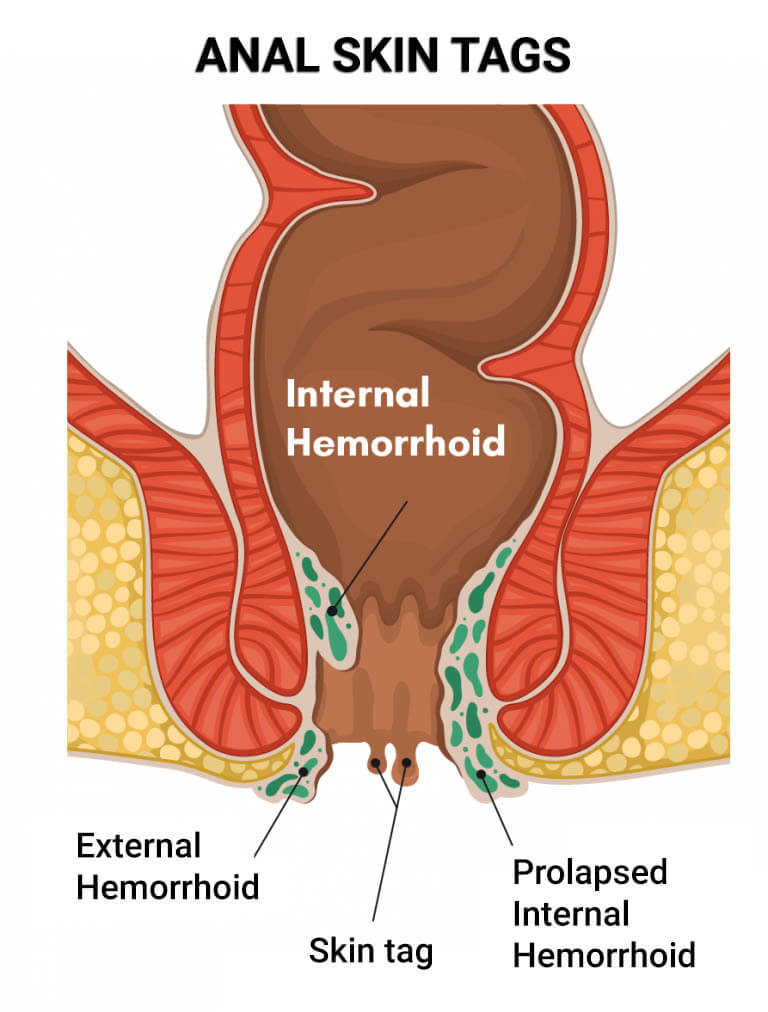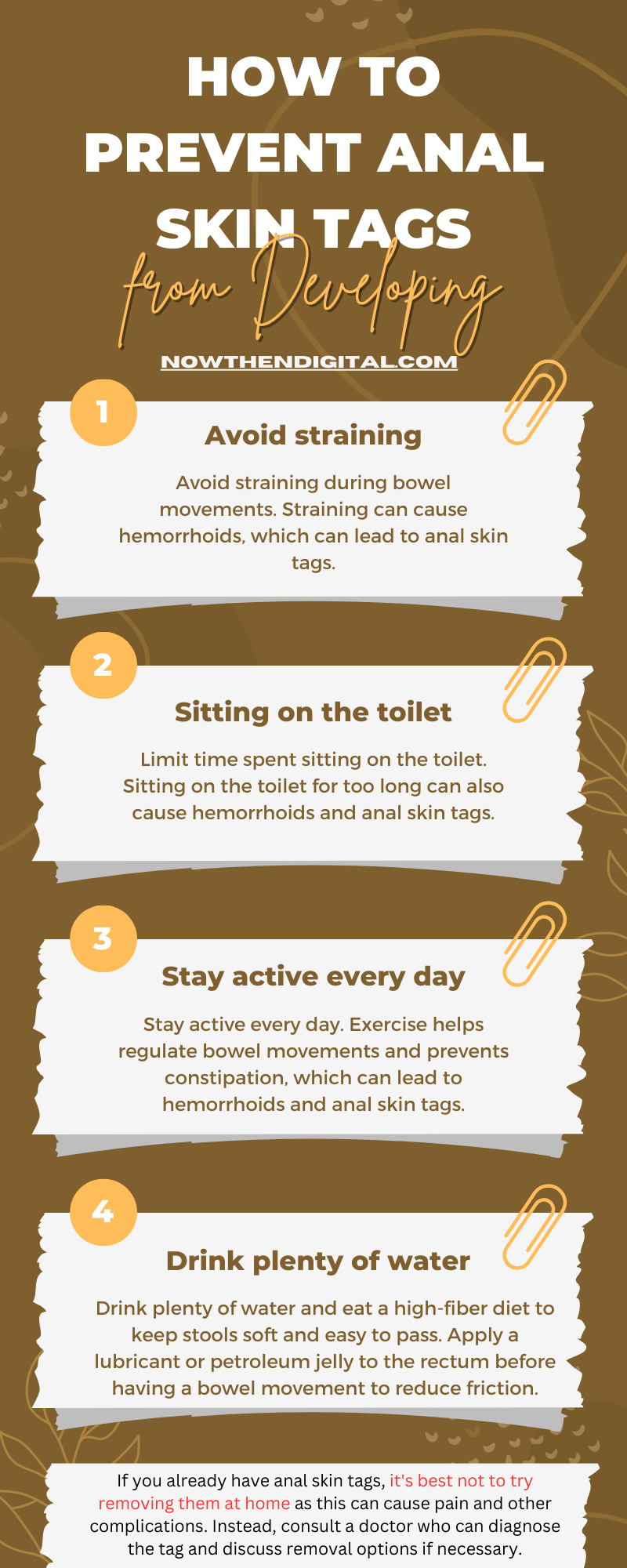The possible causes of anal skin tags include various pathologies of the anus, most commonly hemorrhoids and anal fissures. They can also be caused by friction or irritation increases and areas of friction around the anus.
CUPERTINO, CALIFORNIA | NOW THEN DIGITAL — Anal skin tags are benign skin growths around the anus that are caused by various pathologies of the anus, most commonly haemorrhoids and anal fissures. They are almost always harmless and rarely cause pain, but can cause cosmetic concerns or problems with cleanliness.
What Are Anal Skin Tags?

Anal skin tags are benign skin growths around the anus that are caused by various pathologies of the anus, most commonly hemorrhoids and anal fissures. Typically tiny, they could match your natural skin tone (or slightly darker).
Rectal skin tags are almost always benign and rarely cause pain, but they can cause discomfort, itching, difficulty keeping the area clean, or swelling and pain. Some people are unaffected and unbothered by these tags while others find them to be a cosmetic concern or a problem with cleanliness.
The first step in treating patients with anal skin tags is to figure out the specific symptom caused by the tags. A thorough anal exam allows doctors to determine if there is more to the problem than just the tag. The most common symptom of anal skin tags is the feeling of small bumps or raised areas on the anus.
For example, patients with painful tags often have a chronic anal fissure, a tear inside the anus which has actually caused the tag growth. Since the pain is caused by the fissure, removing the tag alone without treating it will simply lead to regrowth of the tag or worse.
Diagnosis of anal skin tags is typically straightforward, especially if they are easily visible. If not, doctors may use a thin instrument called an anoscope (a small lighted tube) to see just inside the anal opening. Most patients report little or no discomfort during this exam.
Anal skin tag removal is usually an in-office procedure that involves removing extra tissue. It’s rare that you’d need to visit a hospital for this procedure. The removal process is relatively painless as a numbing solution is applied prior to excision.
Recovery time is typically fast – rest on the day of procedure with no heavy lifting and resume normal activities within a week.
After having an anal skin tag removed, talk with your doctor about strategies for preventing future skin tags. You can prevent anal skin tags by being aware of the circumstances that can lead to them.
What Are the Possible Causes of Anal Skin Tags
Skin tags that develop benignly on the anus are known as anal skin tags. Usually only a few millimeters long, and the same or slightly darker in color than the epidermis, they are tiny.
Anal tags usually start small but might grow over time due to repeated trauma from cleaning or recovering from clotted hemorrhoids or anal fissures.
They can also develop due to friction from exercise, prolonged sitting, tight clothing, diarrhea, scarring after the anus heals from other conditions such as anal fissures, and excessive rubbing and cleaning.
Haemorrhoids can cause the skin around the anus to stretch. A tag of flesh is left behind when the hemorrhoid disappears. Anal skin tags may also form due to inflammation caused by Crohn’s disease or another inflammatory condition. Some people may be genetically prone to developing skin tags in general.
Rectal skin tags are usually harmless and do not require treatment unless they cause discomfort or cosmetic concerns. If you suspect you have an anal skin tag, it is important to confirm with your doctor that it is indeed a skin tag and not something else such as a tumor or blood clot.
After removal of an anal skin tag, talk with your doctor about strategies for preventing future skin tags. You can prevent anal skin tags by being aware of the circumstances that can lead to them.
Additionally, excessive rubbing and cleaning, straining from constipation, heavy lifting, strenuous exercise, pregnancy, and hemorrhoids are other possible causes of anal skin tags. It is important to consult with a doctor to determine the underlying cause of anal skin tags.
How to Identify if an Anal Skin Tag Is Benign or Not

Anal skin tags are almost always benign. Diagnosis is typically straightforward, especially if the anal skin tags are easily visible. However, it is important to determine if there is any ongoing hemorrhoidal swelling or symptoms before removal of the tags.
While anal skin tags are generally harmless, unusual-looking tags or pain may indicate something serious. It may be a good idea to see a doctor to confirm the diagnosis and rule out any underlying conditions.
What Are the Available Treatments for Anal Skin Tags
Anal skin tags are benign growths of excess skin around the anus. They are typically small, measuring a few millimeters or less, and the same color as the skin or slightly darker.
ectal skin tags can be left untreated if they do not cause any problems. However, some people may choose to have them removed for cosmetic reasons or if they cause discomfort.
There are several methods for removing anal skin tags. Cryotherapy uses liquid nitrogen to freeze the tag, which will fall off in a few days without further handling. Laser therapy burns the tag away, and any remaining skin falls off.
Scissor excision, electrocautery, or cryosurgery are techniques that a doctor typically uses to remove skin tags. Anesthetic is used to numb the area so that excision is painless.
To prevent complications, doctors may remove only one anal skin tag at a time. This gives the area time to heal and reduces the risk of infection from stool or bacteria.
After removal, patients should avoid lifting heavy objects and doing strenuous activities until they have fully recovered.
Gentle skincare can help rectal skin tags that aren’t causing problems. Avoid scratching, rubbing, and friction. If your skin tags are bothersome, doctors can remove them in-office under local anesthesia with lidocaine.
To prevent rectal skin tags from developing in the first place, it’s important to manage underlying issues such as constipation and anal fissures by taking steps like using stool softeners and practicing good hygiene habits.
The available treatments for anal skin tags include cryotherapy, which uses liquid nitrogen to freeze the skin tag. Without additional processing, the tag will disappear in a few days. Laser treatment is also an option, where the tag is burned away and any remaining skin falls off.
How to Prevent Anal Skin Tags from Developing

Anal skin tags are benign growths that develop around the anus and are usually harmless. However, they can cause cosmetic concerns or problems with cleanliness for some people. Here are some ways to prevent anal skin tags from developing:
- Avoid straining during bowel movements. Straining can cause hemorrhoids, which can lead to rectal skin tags.
- Limit time spent sitting on the toilet. Sitting on the toilet for too long can also cause hemorrhoids and anal skin tags.
- Stay active every day. Exercise helps regulate bowel movements and prevents constipation, which can lead to hemorrhoids and anal skin tags.
- Drink plenty of water and eat a high-fiber diet to keep stools soft and easy to pass.
- Apply a lubricant or petroleum jelly to the rectum before having a bowel movement to reduce friction.
It’s also important to wear underwear that fits well and avoid tight-fitting pants or thong underwear, as these can cause significant friction.
If you already have anal skin tags, it’s best not to try removing them at home as this can cause pain and other complications. Instead, consult a doctor who can diagnose the tag and discuss removal options if necessary.
Preventing anal skin tags can be done by reducing friction in the anal area. This can be achieved by avoiding tight-fitting underwear or pants and wearing well-fitted underwear. Women should avoid wearing thong underwear as it can cause significant friction.
The Best Time to See a Doctor for Rectal skin tags
Anal tags are usually harmless, but they can cause discomfort and concern. If you suspect you have an anal skin tag, it is a good idea to see a doctor to confirm that the bump or bulge you feel is caused by a skin tag and not another condition, such as a blood clot or growth.
A doctor will likely conduct a physical exam and may take a tissue sample or biopsy to make a diagnosis.
Your doctor can discuss your treatment options after making a diagnosis. Some doctors recommend anal skin tag removal, but it may be appropriate to leave the tag unoperated depending on the form and cause of the skin tag.
Rectal skin tags shouldn’t be removed at home because doing so can be painful and lead to other issues. Many at-home removal techniques, particularly in this delicate region, have not been shown to be safe for skin tags.
After the removal procedure, one should make an effort to unwind and stay away from demanding exercise or heavy lifting. Typically, a person can return to work the following day and resume normal activities within days.
You might not need treatment if your anal tags aren’t bothering you and don’t worry you cosmetically. But due to how straightforward it is, many patients prefer to seek therapy. Anal skin tumors are sometimes mistaken for other conditions like warts and hemorrhoids. It is therefore recommended to have an examination at a colon and rectal specialist’s office.

Managing the underlying disease that is causing the tags is the main method of treating perianal skin tags. According to WebMD, perianal skin tags are a condition not limited by age, gender, or familial predisposition, but certain health conditions may elevate the risk.
They are known to be brought on by some conditions, including hemorrhoids and anal fissures. To control the skin tags, you have to treat these conditions first.
You’re reading nowthendigital.com — which breaks the news about Uganda, Kenya, Nigeria, South Africa and the rest of the world, day after day. Be sure to check out our homepage for all the latest news, and follow NOW THEN DIGITAL on YouTube, Google, Web Stories, Google News, Medium, Twitter, Reddit, Pinterest, Linktr, Buy Me a Coffee, and Flipboard to stay in the loop.

















